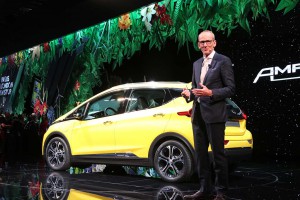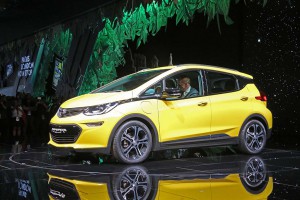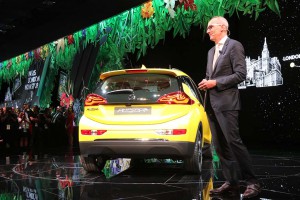European automakers are powering up, and this year’s Paris Motor Show hints at the flood of new battery-based models we’ll be seeing major manufacturers roll out during the next few years.
That includes the new Opel Ampera-e, a slightly revised Euro version of the Chevrolet Bolt battery-electric vehicle we’ll see in U.S. showrooms before the end of this year. Thanks to more lenient European testing procedures, the Ampera-e is expected to deliver 250 miles per charge, or about 12 more than its U.S. near-twin.
“The Ampera-e, with its outstanding range, makes electric mobility fully feasible for everyday use and also lots of fun,” said Opel CEO Karl-Thomas Neumann.
It helps that the new battery-electric vehicle, or BEV, will be able to launch from 0 to 30 in 3.2 seconds and it will hit 60 in around 7 seconds. Not quite Tesla Model S territory, but that’s significantly faster than pretty much any other battery-car now on the road. It will also get more miles on a charge than the upcoming Tesla Model 3. And while European pricing has yet to be released, the Chevy Bolt comes in several thousand dollars under that competitor.
The drivetrain uses a single electric motor making 202 horsepower and 266 pound-feet of torque, more than existing BEVs like the Nissan Leaf, BMW i3 and VW e-Golf. It draws energy from a 60 kilowatt-hour lithium-ion battery pack.

Opel chief Karl-Thomas Neumann said the new Ampera-e is not a second car or a gimmick, but an everyday driver.
That pack has been sewn into the Opel Ampera-e load floor, a move that helps the hatchback deliver significantly more space than with conventional electric vehicle designs that have to sacrifice cabin and cargo space. There’s room for five adults and 13.5 cubic feet of cargo space.
(Paris Motor Show brings big launches, but key makers absent. For more, Click Here.)
The lower battery layout also improves the Opel’s center of gravity which, based on early drives of the Chevrolet Bolt, should mean better handling, as well.
“Our Ampera-e is not eco-luxury, not a gadget and not just a second car. Opel is showing that electro-mobility is also achievable for a much broader audience thanks to the most innovative technology,” said Opel Chief Neumann.
Exactly who the General Motors subsidiary will target with Ampera-e remains to be seen. In the U.S., the Bolt will go after both the retail market and other niches. Chevy plans to offer special discounts, for example, to drivers working for the Lyft ride-sharing service – into which GM invested heavily earlier this year.
(Click Here for more about Volkswagen’s I.D. EV.)
To enhance the appeal further, the body design eliminated the traditional rocker panel to make it easier for passengers to climb in and out of the back seats. That feature will carry over into the Ampera-e.
The new model will hit market slightly after the U.S. sales debut of the Bolt, but it will still have a first-mover advantage in Europe over several other planned, long-range BEVs. The list of coming competitors includes not only the Tesla Model 3, but also the production version of the Volkswagen I.D. concept also debuting in Paris. That model won’t reach the street until 2020, but VW says that the I.D. will offer as much as 375 miles of range.
(To see more about the Smart Fortwo ED, Click Here.)
Opel isn’t laying out sales forecasts, but VW is optimistically projecting battery-car sales of 1 million by 2025. Industry analysts are betting that the longer range offered by BEVs like the Ampera-e, Bolt, I.D. and Model 3 will start pushing electric propulsion from a small eco-niche into a more mainstream technology.


